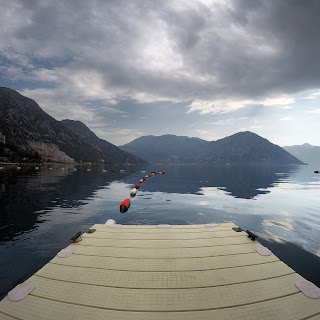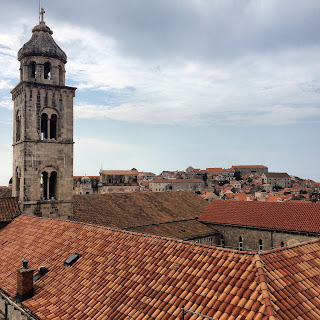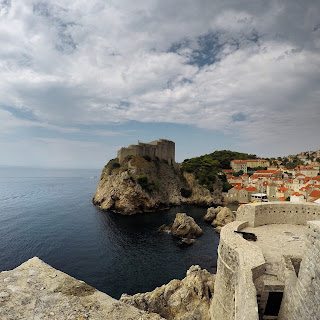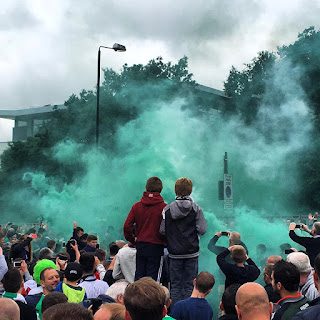RATED a respectful 8/10 by the highly critical Internet Movie
Database website, the 2008 film In Bruges tells the story of two bumbling hit
men sent to the charming Belgium city to lay low after a
failed hit which inadvertently saw a young child killed.
The hitmen, expertly played by Colin Farrell and Brendan
Gleeson, are polar opposites with Gleeson’s character more interested in
soaking up the picturesque sites of the medieval city, whereas the irritable and
somewhat younger Farrell wants to get out and sample some of the myriad of pubs
and bars which line Bruges’ streets and cellars.
What follows is a catastrophic yet comedic chain of events involving
a tactical suicide from the city’s iconic bell tower, a gun chase through the
streets and canals of the city and an angry, cocaine sniffing dwarf.
Whilst this narrative may have proven difficult to top, my
group of friends and I gave it a good go and produced a considerable series of
mishaps ourselves.
Before we set off the plan had been to pick up our hired
minibus, cross the channel and head to a campsite in the north of France, before
making our way into either Lille or Lens to take in the Euro 2016 battle of
Britain between England and Wales.
We had been vociferously warned to watch out for Russian
hooligans and French ultras who attacked English fans in Marseille days before leading to
running battles in the streets of the multi-cultural melting pot port.
Unfortunately violent supporter groups from the continent
still see English ‘hooligans’ as a considerable force to measure up to given
the trail of destruction they left around Europe in the 70s and 80s, and often
target English fans as a way of proving themselves among the trouble making elite.
Although the vast majority of known English trouble makers
have had their passports confiscated and no longer travel, English fans came under
fire from rival groups and predictably fought back. I am in no way saying that
the battles of Marseille were not at all the fault of the English, I just
believe that if you kick a dog so many times it will eventually bite back and
the English supporters, as rowdy and boisterous as they can be, didn’t go to France
specifically looking for trouble as is the case with some of the Russians involved
in the trouble who arrived equipped with well-organised fight tactics and MMA training.
Also the violence that took place in the Stade Velodrome
highlighted the negligence of the French authorities who failed to prevent
Russian supporters from rushing over women and children in the neutral section
and attacking English supporters.
Anyway, I digress.
As we disembarked the ferry and made our way to our first
campsite, we gawped at the sight of the rolling hills, beautifully constructed
properties and quaint towns of the Northern France countryside. After arriving
at our campsite located in the shadow of a country house, we enjoyed a drink in
the sun and a few games of table tennis with other supporters, both English and
Welsh.
The next day we boarded a train and headed to the student
city of Lille recommended for ticketless fans due to the fact it has more bars
and a bigger fanzone.
As soon as we exited the station we were greeted by hoards
of English fans gathering outside bars and indulged in some good-natured ritual
chanting and japes to pass the late morning hours.
The game itself was tight with England recording a late win
thanks to a Daniel Sturridge goal, and we left Lille having enjoyed plenty of
friendly banter and no trouble at all, although I do understand some flashpoints did
develop later in the evening.
Ever since watching In Bruges I’ve always wanted to visit
the city and we rolled into town feeling fresh with a sense of anticipation of
what was in store.
As often portrayed, the city that is home to 118,000 people
is full of cobbled streets, horse and carriages, canals, beautiful buildings
and chocolate shops. Another Venice of the North.
The view from the bell tower was also well worth the 10 Euro admissing fee and gruelling 1,000 odd steps we had to climb to take in the panoramic eyeshot it
offered of the UNESCO World Heritage Site.
It’s fair to say the European Championship atmosphere had
spilled over the border and we enjoyed partying with Dutch and Belgium football
fans, singing songs and dancing into the early hours at some of the busier, bustling pubs and bars.
So far, so good, but when in the early hours two of us split from the group and
began to make our own way back to the campsite, things took a turn for the
worse.
We ended up being enticed into what we now know is a
building frequented by squatters and artists. We were invited in as we passed
and after grabbing a drink from a living room bar open for a monthly party, we
were shown into the dark, graffiti ridden tunnels which the squatters call
home.
Foolishly we managed to lose our guides and spent half an
hour desperately trying to find our way out of the darkened tunnels and court
yards, overlooked by a crumbling chapel. A petrifying experience.
Waking up the next morning it became clear that it was not
only our sense of direction we had lost, but also our bag containing the minibus
keys so we sat at our camp, looking at a minibus we couldn’t enter or start plotting
how we were going to escape the predicament we had found ourselves in.
Like something out of The Hangover, the gruelling eight hour
trek across the city, retracing our steps from the night before, was as
enjoyable as it was successful.
We visited two pubs, a late night bar, a kebab shop, a
police station and rang every taxi company in the city, all to no avail.
Despondently we were forced to get the minibus towed into a
compound and find our way home via taxis and public transport, albeit at an extra
cost of only £50 or so.
One member of the group has since picked up the spare keys
and returned to collect the wagon, however some casual internet research today
has revealed the name of the building where the squatters’ party took place as Donkey Squat.
Frustratingly Donkey Squat was one of the places we returned
in search of the bag the next night after receiving directions from people who
were clearly enjoying some form of outer body, hallucinogenic experience. However we found nobody
home other than an angry Irishman who told us in no uncertain terms that our
lost items weren’t there and we were to leave immediately or risk his wrath. It
seems the parties only take place once or twice each month.
A couple of emails to the party organisers later and the bag and keys are being posted
home. The trip may not have involved suicides, dwarves, drugs or guns, but we
certainly enjoyed our fair share of beer, disasters and new friends.
Another country off the list and more tales to pass down to
future generations.
















































